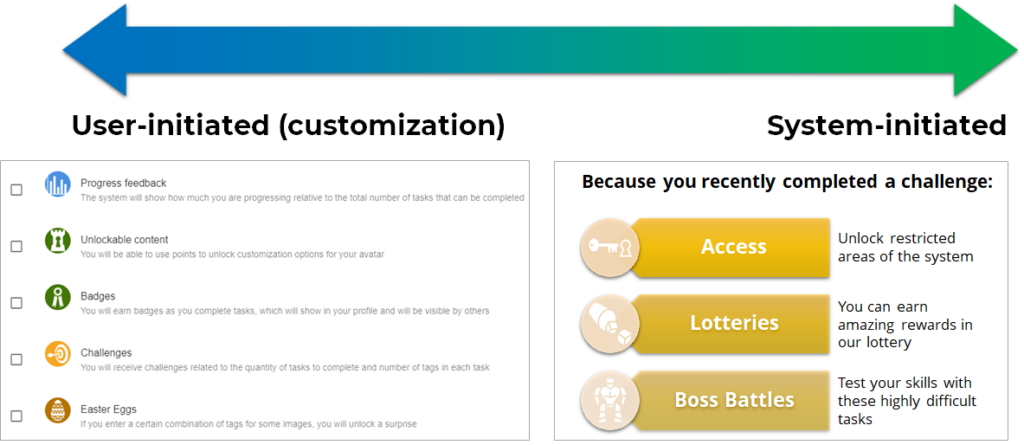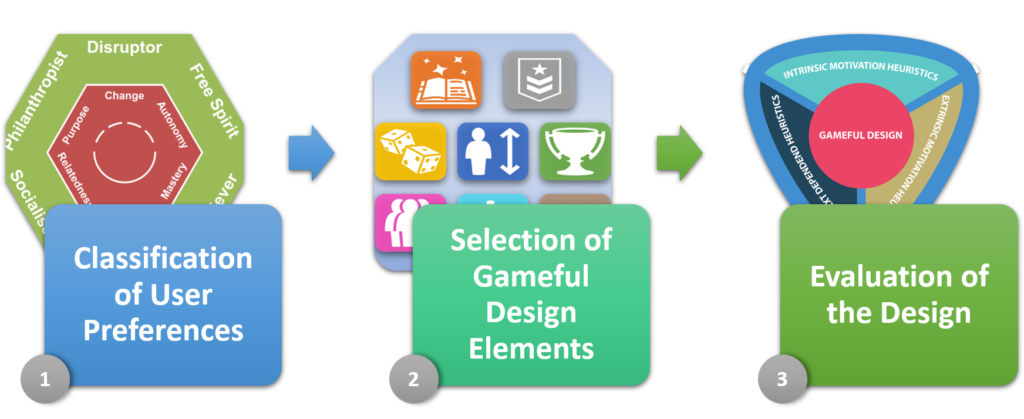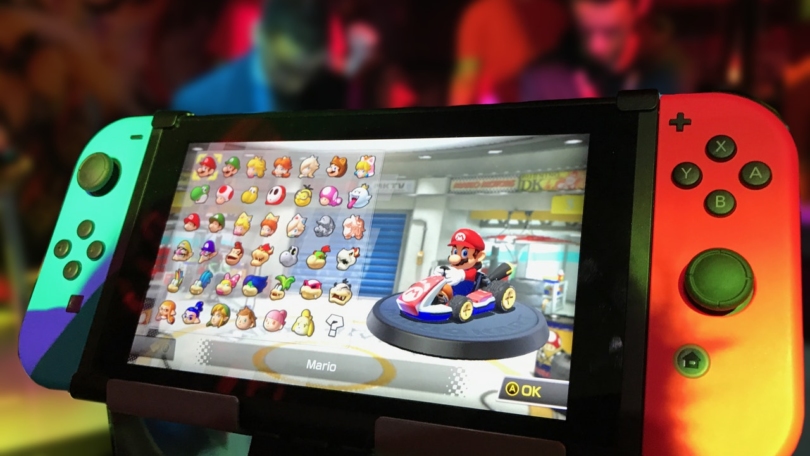I recently presented and published my Ph.D. Thesis describing a method for personalized gameful design. I will now begin publishing a series of posts in this blog introducing and detailing this method so everyone can apply it without needing to read the whole thesis. 🙂
But first, what is Personalized Gameful Design and why should you learn about it?
Definition of Personalized Gameful Design
In my work, I adopt the following definition of personalization, which is detailed in Chapter 3 of my thesis and is based on previous definitions in human-computer interaction research:
Personalization of gameful systems is the tailoring of the gameful design elements by the providers to the users based on knowledge about them, to boost the achievement of the goals of the gameful system.
(Gustavo Fortes Tondello. 2019. Dynamic Personalization of Gameful Interactive Systems. PhD Thesis, University of Waterloo. Chapter 3, p. 60.)
Let’s further detail this definition by exploring the meaning of each part for gamification:
- A gameful system usually employs integrated gameful design elements, that afford a gameful experience while the user accomplishes their goals. To personalize the experience, these elements can be tailored to the preferences of each user. This can be done by enabling or disabling certain gameful elements according to user preferences or by adjusting how certain elements work.
- The providers are the people or organization behind the gameful system, who decide on which content will be offered. Therefore, they need to include elements that can be personalized when they are designing their system.
- The consumers are the users of the gameful system. Each one has their own experience with the system, which is a result of the design of the system and their own past experiences, preferences, and mood.
- The knowledge about the consumers is the models of the user and their preferences. If the provider can obtain this knowledge through the gameful system or other means, it can be integrated into the system and used to automatically personalize the experience, for example, by suggesting what game elements the user is likely to enjoy.
- Finally, users interact with the gameful system with some goals in mind, which vary greatly from system to system, for example, increasing user engagement or interactions with the system, promoting behaviour change, promoting adherence to a specific practice, fostering a community, increasing learning, among others.
Some other authors have used different names or definitions, such as adaptive gamification or tailored gamification, to denote a set of similar ideas. In addition, their methods may vary from mine, especially if they are focused on tailoring other parts of the design instead of the gameful design elements.
1But all the publications about personalized, adaptive, or tailored gamification that I have seen so far all have something in common: they intend to improve the user experience by allowing each user to have a different experience with the system, according to their individual preferences.
You might have noted that the definition is actually for the personalization of gameful systems. By extension, personalized gameful design is the design process to create such systems, which are designed in a way to allow for personalization of the user experience. This can be achieved by user-initiated or system-initiated personalization.
User-initiated vs System-initiated Personalization

User-initiated personalization (or user-controlled personalization) occurs when the system does not tailor contents on its own, but it offers affordances so that the user can make changes to the form and contents of the interface. This form of adaptation is more commonly referred to as customization. Many digital interactive systems offer some form of customization, which can range from the simple selection of the display fonts and colours to complex selections of digital content, activation or deactivation of specific features, or modifications of games.
So, in the context of personalized gamification, customization is allowing users to select which gameful design elements they want to enable or disable for their experience with a system, or allowing them to adjust how the active elements work, for example, by adjusting how many points are awarded for each completed task.
On the other hand, system-initiated personalization (or system-controlled personalization) occurs when the content is automatically tailored to the user, usually with little to no involvement of the latter. It is often found in e-commerce applications, such as the product recommendations made by Amazon based on the users’ and the products’ shopping histories, or in media libraries, such as the movie recommendations made by Netflix.
Therefore, in the context of personalized gamification, (system-controlled) personalization occurs when the system selects which game design elements to enable or disable or adjusts how some of the game elements work, based on the individual preferences of each user, but with little to no intervention from the user.
Potential Benefits of Personalized Gamification
Personalization, in general, has been shown to improve the customer experience and lead to better results. That is why most e-commerce and media distribution systems nowadays include some sort of personalized experience, for example, by recommending products or media that the user is likely to enjoy, based on their knowledge about the user.
Gamification is usually employed to increase user engagement and motivation and to boost the users’ potential to achieve their goals within the system. Therefore, it can be expected that personalized gameful systems will be better in achieving these goals than generic ones.
Presently, we do not have enough scientific evidence yet that this assumption is true; however, several research groups have begun investigating the effects of personalized vs generic gameful systems and the results are promising. For example, Mora et al.
2used personalized gameful in a University classroom and observed that students’ behavioural and emotional engagement was higher in comparison with the same course using a one-size-fits-all gameful design. Moreover, Lessel et al.
3have been comparing different versions of personalized and non-personalized gameful design approaches and their results have been consistently showing that participants in the personalized conditions performed better than in the non-personalized ones.
I am also conducting my own studies of personalized gameful systems designed using the method I proposed. In my pilot study with 50 participants using a customizable gameful image tagging application, the feedback was generally positive. Many participants mentioned that the possibility of customizing their experience helped engage them with the task, for example:
“I feel like it did [influence my enjoyment] because I felt like I kind of created my own game that was perfect for me and so it felt like I was in control and added to my enjoyment.”
(Comment from a participant in my pilot study of personalized gamification. The highlights were added by me. Gustavo Fortes Tondello. 2019. Dynamic Personalization of Gameful Interactive Systems. PhD Thesis, University of Waterloo. Chapter 7.)
I am currently analyzing more data from the follow-up of this study with 200 participants. Therefore, I will soon have more results to publish from this study.
What’s Next: The Method for Personalized Gameful Design
In summary, personalized gameful design is the creation of systems that tailor the user’s experience with the employed gameful design elements, by allowing the user to customize their own experience or automatically tailoring the system according to the system’s knowledge about the user’s preferences.
There is plenty of evidence that personalization is beneficial to increase customer engagement and results in a variety of digital applications, such as e-commerce and media distribution systems. And the preliminary results show that personalized gameful systems can also potentially lead to higher user engagement and better results than systems that offer the same experience to all users.
So, how can we design personalized gameful systems to receive these benefits?
The method for personalized gameful design that I proposed consists of three sequential steps: (1) modelling user preferences, (2) selecting the gameful design elements that are more likely enjoyable for each user, and (3) evaluating the motivational potential of the design.

Notes
- For readers interested in more details, I explain in Chapter 3 of my thesis why I chose to personalize gameful design elements. I also note that there are other parts of the design that could be personalized, such as the user activities, the persuasive strategies, the rewards, and the difficulty of the gameful tasks. Then, I argue that gameful design elements are generally the main factor involved in the affordance of gameful experiences and motivation in gameful systems. Thus, a method for personalization of gameful design elements seems to be what is most needed by the gamification research and practice communities. In comparison, it is not possible to devise a generic method for the personalization of any target activity in gameful systems because gamification is applied to different domain areas. On the other hand, research on the personalization of persuasive strategies is already underway in the field of persuasive technologies and can be adapted to persuasive gameful systems. And finally, rewards and difficulty adjustment are more limited than the selection of different game design elements because they modify the user experience on specific points, whereas modifying the game elements that the user interacts with can potentially change the experience in a very significant way. Therefore, I consider that the personalization of gameful design elements can potentially lead to the highest impact on user experience.
- Alberto Mora, Gustavo F. Tondello, Lennart E. Nacke, and Joan Arnedo-Moreno. 2018. Effect of personalized gameful design on student engagement. In Proceedings of EDUCON 2018.
Alberto Mora Carreño. 2018. A framework for agile design of personalized gamification services. PhD Thesis, Universitat Oberta de Catalunya. - Pascal Lessel, Maximilian Altmeyer, Marc Müller, Christian Wolff, and Antonio Krüger. 2016. “Don’t Whip Me With Your Games” – Investigating “Bottom-Up” Gamification. In Proceedings of CHI ’16.
Pascal Lessel, Maximilian Altmeyer, Marc Müller, Christian Wolff, and Antonio Krüger. 2017. Measuring the effect of “bottom-up” gamification in a microtask setting. In Proceedings of AcademicMindtrek ’17.
Pascal Lessel, Maximilian Altmeyer, Lea Verena Schmeer, and Antonio Krüger. 2019. “Enable or Disable Gamification?” – Analyzing the Impact of Choice in a Gamified Image Tagging Task. In Proceedings CHI ’19.




2 Comments
MrGamification
Useful ???